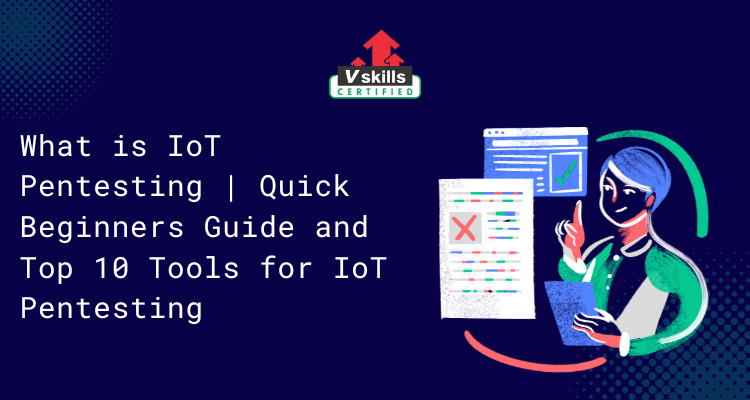In today’s interconnected world, the Internet of Things (IoT) has revolutionized how we live, work, and interact with our surroundings. However, the proliferation of IoT devices has also introduced new vulnerabilities that malicious actors can exploit. To safeguard our digital infrastructure and protect sensitive data, IoT pentesting has become an essential component of cybersecurity.
This blog post will provide a comprehensive guide to IoT pentesting, covering its fundamentals, key processes, and essential tools. By understanding the importance and techniques of IoT pentesting, you can contribute to a more secure and resilient digital landscape.
About the Internet of Things (IoT)
The Internet of Things (IoT) refers to a network of interconnected physical devices, vehicles, home appliances, and other objects embedded with electronics, software, sensors, and network connectivity. These devices can collect and exchange data, enabling automation, remote monitoring, and control.
Components of IoT:
- Devices: Physical objects equipped with sensors, actuators, and connectivity.
- Connectivity: Networks (like Wi-Fi, cellular, or Bluetooth) that enable devices to communicate.
- Data: Information collected by sensors and transmitted through the network.
- Applications: Software that processes and analyzes data to provide insights or trigger actions.
The Need for IoT Pentesting: Protecting Against Vulnerabilities
IoT devices, due to their widespread adoption and often limited security features, are particularly susceptible to various vulnerabilities and risks. These include:
- Lack of Security by Design: Many IoT devices are designed with a focus on functionality rather than security, leading to weak default passwords, lack of encryption, and outdated software.
- Vulnerable Software: IoT devices often run on embedded operating systems and software that may have known vulnerabilities.
- Supply Chain Risks: The complex supply chain involved in manufacturing IoT devices can introduce vulnerabilities at different stages.
- Data Privacy and Security Concerns: IoT devices collect and transmit sensitive data, making them targets for data breaches and privacy violations.
- Remote Access and Control: The ability to remotely access and control IoT devices can be a double-edged sword, as it can also expose them to unauthorized access.
- Denial of Service (DoS) Attacks: IoT devices can be exploited to launch DoS attacks, overwhelming networks or services.
These vulnerabilities can lead to a range of consequences, including:
- Unauthorized access and control: Malicious actors can gain control of IoT devices and use them for nefarious purposes.
- Data breaches: Sensitive data can be stolen or exposed.
- Physical harm: In some cases, compromised IoT devices can pose a physical risk, such as in industrial control systems or medical devices.
- Financial loss: IoT security breaches can lead to financial losses for individuals and organizations.
IoT pentesting Course is crucial for you to identify and mitigate these vulnerabilities, ensuring the security and reliability of IoT systems.
Goals of IoT Pentesting
IoT pentesting aims to identify and assess vulnerabilities in IoT devices, networks, and applications. The primary objectives of conducting IoT pentesting include:
- Vulnerability Identification: Discovering and cataloging potential weaknesses, such as weak passwords, outdated software, and insecure protocols.
- Risk Assessment: Evaluating the potential impact of identified vulnerabilities and prioritizing them based on their severity and likelihood of exploitation.
- Security Posture Assessment: Determining the overall security level of an IoT system and identifying areas for improvement.
- Compliance Verification: Ensuring compliance with industry standards and regulations, such as GDPR, HIPAA, and PCI DSS.
- Incident Response Planning: Identifying potential attack vectors and developing strategies to mitigate and respond to security incidents.
- Security Awareness: Raising awareness among stakeholders about IoT security risks and best practices.
- Continuous Improvement: Providing valuable insights for ongoing security efforts and helping organizations maintain a strong security posture.
By achieving these goals, IoT pentesting can help organizations protect their IoT systems from cyber threats, safeguard sensitive data, and mitigate potential risks.
IoT Pentesting Process
The IoT pentesting process typically involves the following stages:
1. Discovery and Enumeration
- Identifying IoT devices: Using various tools and techniques to detect IoT devices on a network.
- Gathering information: Collecting data about the devices, such as their manufacturer, model, firmware version, and network configuration.
2. Vulnerability Assessment
- Identifying vulnerabilities: Using automated tools and manual techniques to identify known and unknown vulnerabilities in the IoT devices, networks, and applications.
- Prioritizing vulnerabilities: Assessing the severity and potential impact of identified vulnerabilities to prioritize them for exploitation.
3. Exploitation
- Testing vulnerabilities: Attempting to exploit identified vulnerabilities to gain unauthorized access or control.
- Gathering information: Collecting data or evidence from compromised devices.
4. Post-Exploitation
- Gaining persistence: Establishing a foothold on the compromised system to maintain access.
- Lateral movement: Moving from one compromised device to another within the network.
- Privilege escalation: Obtaining higher-level privileges to access sensitive data or systems.
5. Reporting
- Documenting findings: Creating a detailed report summarizing the identified vulnerabilities, their severity, and potential impact.
- Providing recommendations: Offering suggestions for mitigating the identified risks and improving the overall security posture of the IoT system.
6. Remediation
- Implementing patches: Applying security updates and patches to address identified vulnerabilities.
- Configuring devices: Modifying device settings to enhance security, such as disabling unnecessary features or strengthening authentication mechanisms.
- Reviewing policies and procedures: Updating security policies and procedures to prevent future vulnerabilities.
7. Retesting
- Verifying remediation: Conducting follow-up pentesting to ensure that the implemented security measures are effective.
- Identifying new vulnerabilities: Discovering any new vulnerabilities that may have emerged since the initial testing.
By following this process, organizations can effectively identify and address IoT security vulnerabilities, reducing their risk of cyberattacks and protecting their valuable assets.
Top 10 Tools for IoT Pentesting
The following are three of the most popular and effective tools for IoT pentesting:
1. Nmap
- Purpose: Network mapper used to discover hosts and services on a network.
- Key features: Can scan for open ports, identify operating systems, and detect vulnerabilities.
- How to use: Nmap offers a wide range of options and commands to customize scans and gather detailed information about IoT devices.
2. Metasploit
- Purpose: Penetration testing framework that allows for the development and execution of exploits.
- Key features: Includes a vast database of exploits and modules for various vulnerabilities, making it a powerful tool for attacking and exploiting IoT devices.
- How to use: Metasploit can be used to automate attack scenarios, test vulnerabilities, and gain unauthorized access to IoT systems.
3. Wireshark
- Purpose: Packet analyzer used to capture and analyze network traffic.
- Key features: Can be used to inspect network traffic, identify anomalies, and detect potential security threats.
- How to use: Wireshark can be used to analyze IoT device communication, identify vulnerabilities, and gather evidence of attacks.
4. Shodan
- Purpose: Search engine for IoT devices and services.
- Key features: Allows users to search for devices based on their manufacturer, model, firmware version, and other attributes.
- How to use: Shodan can be used to discover IoT devices on the internet and identify potential vulnerabilities.
5. IoT Inspector
- Purpose: Automated IoT security scanner.
- Key features: Can scan for vulnerabilities, identify weak credentials, and detect misconfigurations.
- How to use: IoT Inspector can be used to quickly assess the security of IoT systems and identify potential risks.
6. Zmap
- Purpose: High-performance network scanner.
- Key features: Can scan large networks quickly and efficiently, making it ideal for discovering IoT devices.
- How to use: Zmap can be used to identify IoT devices on a network and gather information about them.
7. Yara
- Purpose: Malware analysis tool that can be used to identify and detect malicious code targeting IoT devices.
- Key features: Allows users to create custom signatures to detect specific types of malware.
- How to use: Yara can be used to analyze IoT device firmware and network traffic for signs of malicious activity.
8. OpenVAS
- Purpose: Vulnerability scanner that can be used to identify vulnerabilities in IoT devices and networks.
- Key features: Includes a large database of vulnerabilities and can be customized to scan specific types of devices.
- How to use: OpenVAS can be used to automate vulnerability scanning and identify potential security risks.
9. Scapy
- Purpose: Python-based interactive packet manipulation tool.
- Key features: Allows users to craft and send custom packets to test IoT device responses.
- How to use: Scapy can be used to simulate attacks and test the resilience of IoT systems to various threats.
10. Acunetix
- Purpose: Web application vulnerability scanner that can also be used to scan IoT devices with web interfaces.
- Key features: Can identify vulnerabilities such as SQL injection, cross-site scripting, and cross-site request forgery.
- How to use: Acunetix can be used to assess the security of IoT devices with web interfaces and identify potential risks.
These tools, along with the others mentioned previously, can be invaluable assets for security professionals conducting IoT pentesting. By leveraging these tools, organizations can effectively identify and mitigate vulnerabilities, protecting their IoT systems from cyber threats.
Ethical Considerations in IoT Pentesting
IoT pentesting, while essential for ensuring the security of IoT systems, must be conducted ethically and responsibly. Here are some key ethical considerations to keep in mind:
- Obtain Proper Authorization: Always obtain explicit permission from the owner or authorized representative of the IoT system before conducting any pentesting activities. Unauthorized access can be considered illegal and unethical.
- Respect Privacy: Be mindful of privacy concerns and avoid collecting or disclosing any personal or sensitive information that is not necessary for the pentesting process.
- Avoid Causing Harm: Take precautions to minimize any potential harm or disruption to the IoT system or its users. This includes avoiding actions that could compromise the system’s functionality or cause physical harm.
- Responsible Disclosure: If you discover vulnerabilities, follow responsible disclosure practices. This typically involves reporting the vulnerabilities to the vendor or owner in a confidential manner and giving them time to address the issues before making the information public.
- Adhere to Legal Requirements: Ensure that your pentesting activities comply with all applicable laws and regulations, including data protection laws, cybercrime laws, and export control regulations.
- Respect Intellectual Property: Avoid infringing on any intellectual property rights, such as copyrights or patents, associated with the IoT system.
- Consider Social Impact: Be aware of the potential social or economic consequences of your pentesting activities. Avoid actions that could harm individuals, businesses, or communities.
By adhering to these ethical principles, IoT pentesting can be a valuable tool for improving the security of IoT systems while respecting the rights and interests of all stakeholders.
Final Words
IoT pentesting is a critical component of ensuring the security and reliability of IoT systems. By understanding the fundamentals of IoT pentesting, the key processes involved, and the essential tools available, organizations can effectively identify and mitigate vulnerabilities, protecting their valuable assets from cyber threats.
Remember to conduct IoT pentesting ethically and responsibly, obtaining proper authorization, respecting privacy, and avoiding causing harm. By following these guidelines, organizations can contribute to a more secure and resilient digital landscape.
 Stay Ahead with the Power of Upskilling - Invest in Yourself!
Stay Ahead with the Power of Upskilling - Invest in Yourself! 




